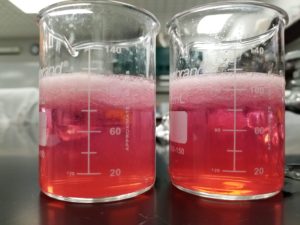Welcome Back to School: Re-grounding in the Scientific Process // Peter's Blog // October 6th, 2021
One of the goals I have for many of the labs we do in Biotechnology is to have students involved in some aspect of the experimental design. I find that students are far more invested in the results if they are responsible for designing some aspect of procedure. This works even better when they feel that they are making recommendations for next year’s Biotechnology class – “which temperature works best for heat shock transformation?” or “what volume of sample works best in PCR?” Such a simple change switches the lab from a simple “cookbook” demonstration to one where their results will impact what happens in future classes.
Except . . .
This past semester I had students optimize how much DNA could be purified from strawberries. This is the typical lab which uses household products like soap, salt, meat tenderizer (protease), and rubbing alcohol to precipitate DNA. Look on the internet and you will find many, many different sets of directions with varying recommendations for reagent amounts, length of reaction time and the order in which the reagents should be added. All of them work – all yield DNA – but, what process yields the most?
Students were given a recommended set of directions and then told to modify one variable. Some varied the type of soap, some changed the amount of salt, and others changed the type of alcohol (ethanol vs. rubbing alcohol). They made predictions which included why they thought those results would (an important part of science). They saw their results and made recommendations, based on those results, about what next year’s class should try next – just because more salt yielded more DNA, for example, next year’s class should try even more salt.
Except . . .
A pair of students asked THE question which all science teachers dread: “But what’s the answer?” They had varied the amount of salt. They saw that more salt yielded more DNA, but they wanted to know the right answer and thought that, somehow, I knew what the CORRECT amount of salt should be.
I felt like their questions had defeated the whole concept of doing the experiment and that I had failed to communicate clearly that I was learning along with them. It took some time for me to convince them that I didn’t have THE answer and that it wasn’t because I didn’t know what I was doing.
I was reminded that students are so used to learning “indisputable” facts that should never be questioned that they need reassurance that it is “okay” to investigate things which are not known. Importantly, that new information would guide future understanding which might even change again. What if the next experiment showed that EVEN MORE salt yielded EVEN MORE DNA? What should next year’s Biotech class do?
In fact, isn’t that the true definition of the scientific process? Science is about asking questions, gathering data, using that data to modify your understanding, and then testing that understanding with more experiments . . . which might further refine your understanding. It seems that this is probably the most important point to impress on our students as it has often been forgotten throughout this pandemic. It is our responsibility as science teachers to make sure that students understand the scientific process and that they can be a meaningful part of it.
Until next month.
Note: There is a corresponding Virtual Teacher Meet re: this topic scheduled for 7-8pm on October 25th. Hope to see you there!
